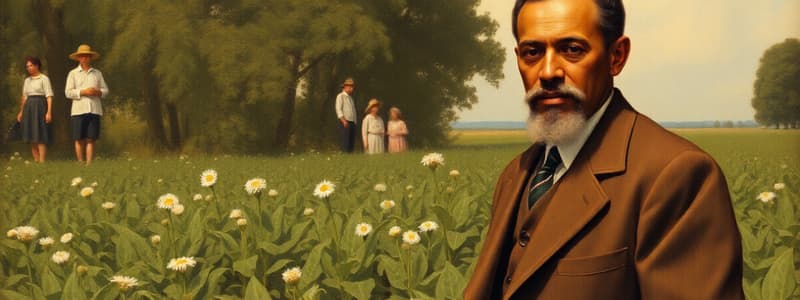Podcast
Questions and Answers
What primary economic issue was George Washington Carver aiming to address in the Southern US?
What primary economic issue was George Washington Carver aiming to address in the Southern US?
- Limited access to markets for agricultural products.
- Insufficient labor force for crop harvesting.
- Lack of agricultural education among ex-slaves.
- Over-reliance on cotton farming leading to soil depletion. (correct)
Which institution did Booker T. Washington lead, where Carver later became the director of agriculture?
Which institution did Booker T. Washington lead, where Carver later became the director of agriculture?
- Tuskegee Institute. (correct)
- The US House of Representatives
- Spingarn Institute.
- Iowa State Agricultural College.
What was the primary benefit of the crops that Carver encouraged farmers to grow instead of cotton?
What was the primary benefit of the crops that Carver encouraged farmers to grow instead of cotton?
- They were more resistant to pests common in the South.
- They helped restore nitrogen to the soil. (correct)
- They required less water and maintenance.
- They could be sold at a higher price than cotton.
Approximately how many products did Carver manage to develop from peanuts and sweet potatoes?
Approximately how many products did Carver manage to develop from peanuts and sweet potatoes?
What recognition did Carver receive following his presentation to the US House of Representatives?
What recognition did Carver receive following his presentation to the US House of Representatives?
Which of the following best describes Carver's approach to helping ex-slaves in Alabama?
Which of the following best describes Carver's approach to helping ex-slaves in Alabama?
What key concept links Carver's agricultural innovations with his broader vision for African Americans in the early 20th century?
What key concept links Carver's agricultural innovations with his broader vision for African Americans in the early 20th century?
Imagine a scenario where a new invasive species devastates peanut crops in the South. Based on Carver's methodology, what would be the MOST strategic, long-term approach to mitigate the agricultural and economic impact?
Imagine a scenario where a new invasive species devastates peanut crops in the South. Based on Carver's methodology, what would be the MOST strategic, long-term approach to mitigate the agricultural and economic impact?
Flashcards
George Washington Carver
George Washington Carver
An African American agricultural scientist who helped restore the Southern US economy.
Problem with Cotton
Problem with Cotton
Exclusive cultivation of cotton depleted soil nutrients in the South.
Peanuts, sweet potatoes, soybeans
Peanuts, sweet potatoes, soybeans
Nitrogen-rich crops encouraged by Carver to restore the soil.
Carver's Product Research
Carver's Product Research
Signup and view all the flashcards
Tuskegee Institute
Tuskegee Institute
Signup and view all the flashcards
Carver's role at Tuskegee
Carver's role at Tuskegee
Signup and view all the flashcards
US House of Representatives
US House of Representatives
Signup and view all the flashcards
Spingarn Medal
Spingarn Medal
Signup and view all the flashcards
Study Notes
- George Washington Carver, an African American agricultural scientist, played a vital role in revitalizing the Southern US economy.
- He introduced innovative soil improvement and crop cultivation techniques.
- Carver developed marketable products from alternative crops to cotton.
Early Life and Education
- Born into slavery in Missouri, Carver pursued education after slavery's abolishment in 1865.
- He was the first African American to enroll at Iowa State Agricultural College.
- Carver earned a master’s degree in agriculture in 1896.
Tuskegee Institute and Agricultural Innovation
- Carver became the director of agriculture at the Tuskegee Institute under Booker T. Washington.
- He dedicated himself to improving southern agriculture.
- Carver taught sustainable farming methods and techniques to ex-slaves.
- His goal was to enable them to become self-sufficient.
- He oversaw the Agriculture Department at Tuskegee Institute for 47 years.
Restoring the Southern Economy
- In the late 19th century, cotton farming depleted soil nutrients, causing low yields.
- Carver promoted the cultivation of peanuts, sweet potatoes, and soybeans.
- These crops were nitrogen-rich and helped revitalize the soil.
- From 1900 to 1920, 287 products derived from peanuts were invented.
- He also invented 118 products from sweet potatoes.
- Carver's research led to over 400 marketable products, including oils and dyes.
- These boosted financial yields and transformed the South led to being a key contributor to the US agricultural industry.
Recognition
- In 1921, he spoke before the US House of Representatives and received a standing ovation from peanut farmers.
- Carver received the Spingarn Medal in 1923 for outstanding achievement, among other honors.
Studying That Suits You
Use AI to generate personalized quizzes and flashcards to suit your learning preferences.




